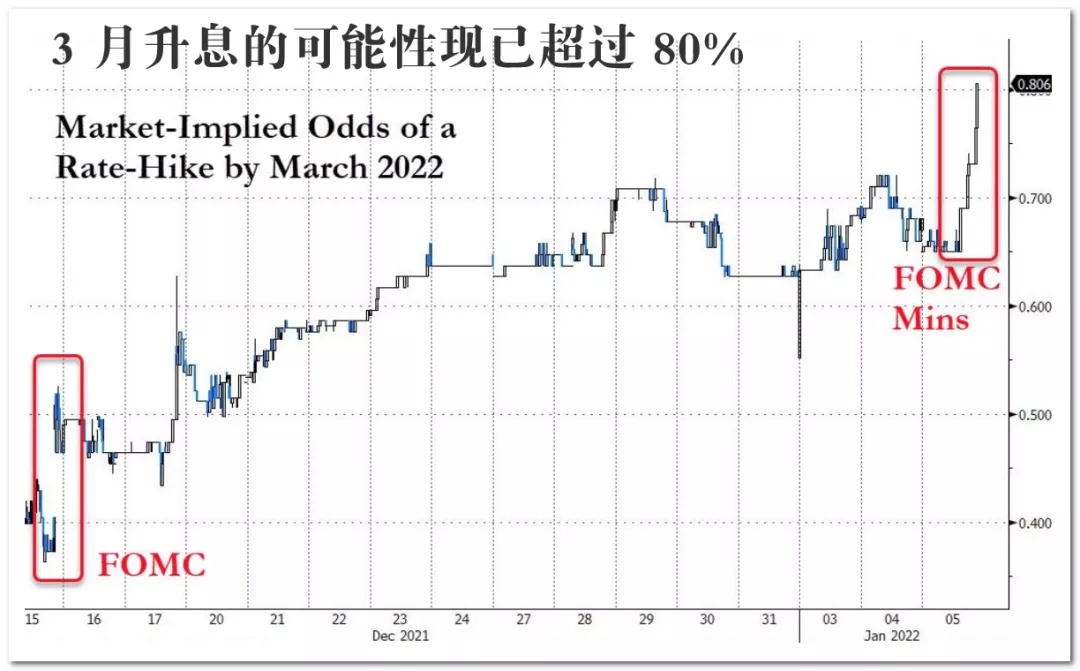-The minutes of the meeting hardly changed anything, but they strengthened the Fed's intention to raise interest rates, which is of great significance.
At 3:00 a.m. Beijing time on Thursday, the Federal Reserve released a "world-wide surprise" meeting minutes (explanation).
The Fed usually issues meeting minutes in the third week after the meeting. Since the contents of the meeting have already been announced, the meeting minutes are only a supplement to the details, so they have little impact on the market.
Except this time.
The latest minutes of the meeting were released in December. At the meeting at that time, the Federal Reserve announced an acceleration in taper and hinted that it would raise interest rates three times in 2022. After the storms of December, traders thought the minutes were just a formality, but they were shocked at the moment they were being released.
Shock one:
Fed officials' idea of raising interest rates is more "radical"-raising interest rates earlier and faster than expected.
Summary of the meeting: Participants generally pointed out that, given their personal views on the economy, the labour market and inflation, it may be necessary to raise interest rates sooner and faster than previously expected.
In December, we knew that the Fed's idea of raising interest rates was still on a cold bitmap, and the phrase "participants generally pointed out" proved that this was almost everyone's idea.
The Fed's suggestion makes people feel that the time of raising interest rates may be advanced to March.
Shock two:
Fed officials talk openly about "shrinking the balance sheet". Before investors even reacted to raising interest rates, the Federal Reserve already mentioned "shrinking the table".
Summary of the meeting: Some participants said that after the interest rate increase, it may be appropriate to start reducing the balance sheet size relatively quickly, and the appropriate time for reducing the balance sheet may be closer to the time of interest rate increase. Some members believe that in the process of balance sheet normalization, it may be appropriate to reduce the balance sheet significantly.
Shrinking the balance sheet is still a strange word for ordinary investors. To know that all the secrets of financial market movements are hidden in the balance sheet of the Federal Reserve.
Although the Fed does not have a clear time estimate, the minutes suggest that it will shrink the table faster and more violently than the last one. In the last interest rate hike cycle, the Federal Reserve began to shrink its table almost two years after raising interest rates, and this time it has a high probability of shrinking its table this year, so it is conceivable how severe the situation is.
In fact, there was a big news that was ignored by financial markets at the beginning of this week: the most dovish officials of the Federal Reserve surrendered.
Neel Kashkari, chairman of the Minneapolis Federal Reserve, wrote that he supported raising interest rates twice this year to deal with the risks brought by inflation. Move the two rate hikes forward to 2022 because inflation is higher and more persistent than expected. Since becoming president of the Minneapolis Fed in 2016, Kashkari has been the most dovish decision maker of the Fed.
As a policy maker, the Fed usually avoids disturbing the market. Every Fed policy-making official knew that every word and discussion he made at the meeting could bring unprecedented turmoil to the market, but they did it anyway. In just one meeting, they talked about all three options: "reducing QE, raising interest rates and shrinking the table". They didn't think about the problems that their change might bring to the stock market and bond market, leaving no time for the market to react.
I'll tell you why the Fed did this:
First, in order to regain the "guiding right" to market expectations. Since last year, it has been obvious that the Fed has been led by "market expectations". Every time, from reducing QE to raising interest rates, expectations were made several months in advance, and the Fed's response lagged far behind expectations.
Let me make a timetable. How long do you think the Fed lags behind the market:
April 29, 2021: It is said that it is not yet time to discuss reducing QE (at this time, the market has already called for it);
June 17, 2021: Change the mouth and have begun to discuss reducing QE;;
November 3, 2021: Officially announced the reduction of QE.
Second, let the market pay for the Fed's misjudgment (inflation).
I was really shocked by the shamelessness of the Federal Reserve.
Obviously, the financial market is in chaos.
-The US stock market fell across the board, the Dow Jones index fell 1.07%, the S&P 500 index fell 1.90%, and the Nasdaq index fell 3.34%;
-The yield of 10-year US bonds exceeded 1.70%, the highest level since the beginning of April 2020;
-The international gold price has turned from rising to falling, falling more than 20 US dollars from the high point of the day;
-Bitcoin fell to its lowest level since the flash crash in December last year, once falling 3.6% to $44,567.
We will be greeted by more turbulent moments.
$NQ100指数主连 2203(NQmain)$ $黄金主连 2202(GCmain)$ $WTI原油主连 2202(CLmain)$ $A50指数主连 2201(CNmain)$

Comments
[Salute] [Salute]